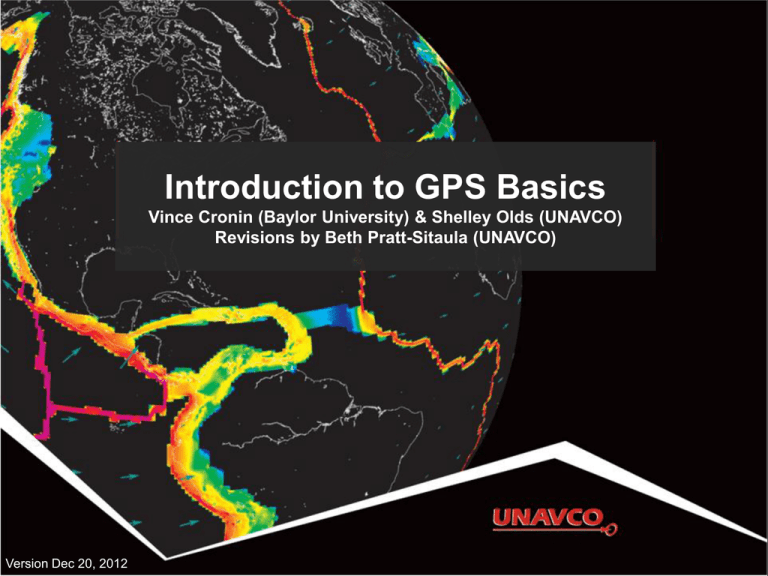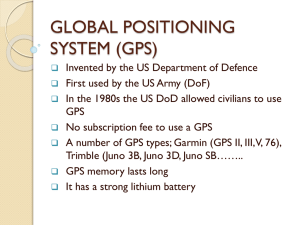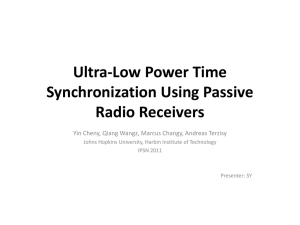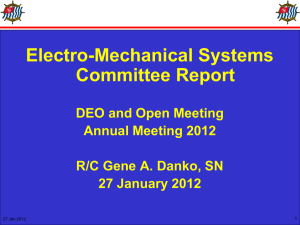Presentation: Intro to GPS
advertisement

Introduction to GPS Basics Vince Cronin (Baylor University) & Shelley Olds (UNAVCO) Revisions by Beth Pratt-Sitaula (UNAVCO) Version Dec 20, 2012 GPS receiver GPS receiver GPS receiver The Global Positioning System • • • • • • 24-32 satellites 20,200 km altitude 55 degrees inclination 12 hour orbital period 5 ground control stations Need 4 satellites to be accurate • Each satellite passes over a ground monitoring station every 12 hours GPS Satellite Images from Lockeed-Martin (http://www.lockheedmartin.com/products/GPS/) Consumer-grade GPS accuracy • Horizontal: +/- 10 m (30 ft) error • Vertical: +/- 15 m (45 ft) error Your location is: 37o 23.323’ N 122o 02.162’ W Anatomy of a High-precision Permanent GPS Station GPS antenna inside of dome Monument solidly attached into the ground with braces. If the ground moves, the station moves. Solar panel for power Equipment enclosure • GPS receiver • Power/batteries • Communications/ radio/ modem • Data storage/ memory 8 High-precision GPS • • • • • • • • Current accuracies sub-cm. Use the carrier phase Dual-frequency receivers High-precision orbital information Good monuments Multiple stations Sophisticated processing software Collect lots of data GPS & atomic clocks Each GPS satellite has 4 atomic clocks, to be sure that one is always working. Each costs ~$100,000, and is accurate to 1 billionth of a second (1 nanosecond). http://www.kowoma.de/en/gps/satellites.htm Almanac & Ephemeris data • GPS satellites include almanac and ephemeris data in the signals they transmit • Almanac data are coarse orbital parameters for all GPS satellites • Ephemeris data are very precise orbital and clock correction for that particular GPS satellite--necessary for precise positioning http://gpsinformation.net/main/almanac.txt How satellite-receiver distance is measured • Radio signal from satellite tells GPS receiver the satelliteclock time and provides the most recent corrections to the satellite’s position relative to Earth (ephemeris) • GPS receiver compares the satellite-times to receivertime to determine the distance to each satellite How actual location is determined • Receiver position is triangulated using at least 3 satellites, 4th needed to adjust the receiver’s time. Sources of Error Some GPS Error Sources • Selective Availability • Satellite orbits • Satellite and receiver clock errors • Atmospheric delays Ionosphere Troposphere • Multi-path • Human errors The New Yorker, Roz Chast 14 GNSS/GPS stations globally • >4000 stations with more added all the time • Some data freely available, some not • GNSS = Global Navigation Satellite System http://gsrm.unavco.org/data/images/1.2/sites.jpg Plate Boundary Observatory (PBO) PBO involves installation, operation and maintenance of >1100 continuously operating high-precision GPS stations (plus >170 other instruments: strainmeters, borehole seismometers and tiltmeters) http://pbo.unavco.org/network/gps/; http://www.earthscope.org/ Where is that chunk of crust going? • Example: using GPS velocities to understand plate motions Two PBO stations in California • Twenty-nine Palms,(BEMT) • Mission Viejo (SBCC) GPS time series data • Station position over time North-South East-West Up-Down http://pbo.unavco.org/station/overview/SBCC GPS time series data • From the changing position velocity can be calculated using slope (rise-over-run) http://pbo.unavco.org/station/overview/SBCC Detrended GPS time data PBO also supplies “detrended” data with the average velocity subtracted out to observe other phenomena. In that case official velocity is given. What is a site’s 3D speed? Using the Pythagorean Theorem (high school math...), What compass direction is the site moving? Using the horizontal components of velocity, and a bit of high-school trigonometry… 43.9°west of north or 316.1°azimuth Map view of velocity 20 mm/yr Two different velocities Why the difference? 20 mm/yr Same process yields much slower velocity at BEMT San Andreas Fault! 20 mm/yr Reference Frames All velocities are RELATIVE to a given reference frame • Velocities compared to International Terrestrial Reference Frame 2000 • Hot spot constellation as “stable” Reference Frames All velocities are RELATIVE to a given reference frame • Velocities compared to Stable North America Reference Frame • Eastern North America as “stable”











